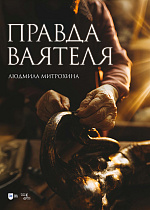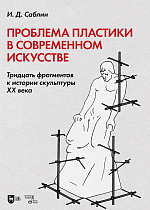Композиция и мастерство скульптурной обработки материалов - все книги по дисциплине. Издательство Лань
Сохранить список:
Excel
Excel
Закрыть
Выгрузка списка книг доступна только авторизованным пользователям. Авторизоваться
Книга «Правда ваятеля» посвящена известному петербургскому скульптору Тамаре Викторовне Дмитриевой (псевдоним — ТАВИДИ), заслуженному художнику РФ, члену Санкт-Петербургского регионального отделения Союза художников России, посвятившей пластическому искусству более шестидесяти лет. Книга отражает основные этапы творчества скульптора, впитавшего в себя наследие мирового искусства всех эпох от классического академизма до современного символического звучания. Работы петербургского ваятеля — это и портреты (как исторические, так и современные), декоративные и монументальные скульптуры, аллегорические произведения, конкурсные проекты, графика и декоративно-прикладное искусство. Особое место занимает создание уникального исторического памятника «Пётр Рикорд и Такадая Кахей», установленного в Японии в г. Госики-Тё и в Кронштадте. ТАВИДИ выработала свой индивидуальный узнаваемый стиль, наполненный полемичностью, иронией, духовностью, символизмом, с новейшим художественным осмыслением исторических событий, выраженных ярким талантливым пластическим языком.
The book “The Sculptor’s Truth” is dedicated to the famous sculptor from St. Petersburg Tamara Viktorovna Dmitrieva (pseudonym TAVIDI), Honored Artist of the Russian Federation, member of the St. Petersburg regional branch of the Union of Artists of Russia, who devoted more than sixty years to plastic art. The book covers the main stages of the sculptor’s work, which absorbed the world art heritage of all eras from classical academicism to modern symbolic image. The works by the St. Petersburg-based sculptor include portraits (both historical and contemporary ones), decorative and monumental sculptures, allegorical works, contest projects, graphics, and decorative and applied art. A special place is occupied by the creation of a unique historical monument “Peter Ricord and Takadaya Kahei”, installed in the city of Goshiki-Cho (Japan) and in Kronstadt. TAVIDI has worked out her own personal characteristic style, filled with controversy, irony, spirituality, symbolism, with the latest artistic understanding of historical events, expressed by a vivid and gifted plastic language.
The book “The Sculptor’s Truth” is dedicated to the famous sculptor from St. Petersburg Tamara Viktorovna Dmitrieva (pseudonym TAVIDI), Honored Artist of the Russian Federation, member of the St. Petersburg regional branch of the Union of Artists of Russia, who devoted more than sixty years to plastic art. The book covers the main stages of the sculptor’s work, which absorbed the world art heritage of all eras from classical academicism to modern symbolic image. The works by the St. Petersburg-based sculptor include portraits (both historical and contemporary ones), decorative and monumental sculptures, allegorical works, contest projects, graphics, and decorative and applied art. A special place is occupied by the creation of a unique historical monument “Peter Ricord and Takadaya Kahei”, installed in the city of Goshiki-Cho (Japan) and in Kronstadt. TAVIDI has worked out her own personal characteristic style, filled with controversy, irony, spirituality, symbolism, with the latest artistic understanding of historical events, expressed by a vivid and gifted plastic language.
В книге рассматривается роль скульптуры в XX столетии и в предшествующие века истории искусства. Ставится вопрос о природе пластического. Что это: (сколь угодно вольная) вариация на тему человеческого тела или же попросту любой предмет в пространстве? В зависимости от ответа можно представить современное состояние данного вида искусства либо как критическое, предполагающее сомнения в жизнеспособности пластики, либо переживающим небывалый расцвет, ведь с точки зрения трехмерных предметов практически всё в наши дни стало скульптурой. Склоняясь к первому варианту, автор высказывает надежду на продолжение истинно пластических, т. е. связанных с репрезентацией тела художественных практик, – совершенно необязательно в том (узком) смысле, который придают теперь понятию «телесность».
The book examines the role of sculpture in the 20th century and in previous centuries of art history. The question is raised about the nature of the plastics. What is this: (to any degree free) variation on the theme of the human body, or simply any object in space? Depending on the answer, one can present the current state of this art form either as critical, doubting the viability of plastics, or experiencing an unprecedented peak, because from the point of view of three-dimensional objects, almost everything today has become a sculpture. Leaning towards the first point of view, the author hopes that the truly plastic, that is, those associated with the representation of the body, artistic practices are to be continued — not necessarily in the (narrow) sense that is now given to the concept of “corporeality”.
The book examines the role of sculpture in the 20th century and in previous centuries of art history. The question is raised about the nature of the plastics. What is this: (to any degree free) variation on the theme of the human body, or simply any object in space? Depending on the answer, one can present the current state of this art form either as critical, doubting the viability of plastics, or experiencing an unprecedented peak, because from the point of view of three-dimensional objects, almost everything today has become a sculpture. Leaning towards the first point of view, the author hopes that the truly plastic, that is, those associated with the representation of the body, artistic practices are to be continued — not necessarily in the (narrow) sense that is now given to the concept of “corporeality”.
Закрыть
Сообщить о поступлении
Укажите ваш e-mail, и мы пришлем уведомление, как только книга
станет доступна для покупки.



